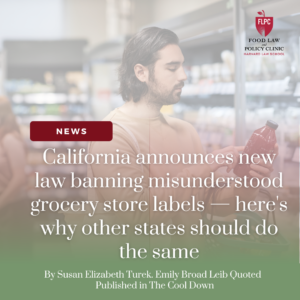This post was originally written by Emily Broad Leib and Doug O’Brien, and it was published in USA Today on September 28, 2022.
As the international community gathers at the United Nations General Assembly, countries should enact policies that leverage food banks as a long-term solution to current and future food crises.
More than 3 billion people worldwide cannot afford a healthy diet, according to the United Nations. High food prices and rising inflation across the globe are expected to increase this number.
Those living in low- and middle-income countries are especially vulnerable as they spend a larger share of their incomes on food. With climate change and conflict driving up the cost of living, nutritious food is moving out of reach for even more people.
At the same time, roughly a third of food produced for human consumption goes to waste each year globally. As the consequences of food waste on both the environment and food security mount, the world cannot afford to lose so much viable food. With the cost of living crisis in full swing, governments can make better use of food banks to address hunger and inefficient food systems.
Clarify ‘best before’ and ‘use by’ dates for food donors
Since 2020, food banks have seen an unprecedented need for food assistance. During the same period, many food banks are reporting as much as a 50% decrease in food donations. To fully enable food banks to reduce food insecurity, governments must implement policies that break down barriers to food donation, rather than hinder it.
To start, governments should adopt date labeling laws on food that clearly differentiate quality-based and safety-based dates. In some cases, “best before” and “use by” dates are marked interchangeably by food production companies. However, a growing number of countries are passing laws to clarify that while the former provides a flexible limit for when food is no longer the best quality for customers, the latter is used on foods as a stricter limit to know when food is no longer safe to eat.
Confusion around these different date labels often leads to the disposal of perfectly good food. About 84% of Americans report that they throw away food near the date on the packaging due to safety concerns, regardless of date label type.
Clearer policy and education can help mitigate the confusion that arises around date labels. The United Kingdom, for instance, developed a detailed legal framework outlining the difference between “use by” and “best before” dates. Government guidance clearly states that foods past their “best before” date can still be donated to food banks. The government has also undertaken extensive education campaigns with food loss and waste organizations to reduce consumer confusion on date labeling.
Liability protections and tax incentives for food donations
Another barrier to food donation is the concern of being held legally responsible if someone were to become ill from donated food. Consequently, many potential donors avoid contributing safe, wholesome food at all. To help overcome this, governments can provide comprehensive liability protection to donors and food banks for donations that meet all food safety laws.
The United States was the first country to offer liability protections for food donations, and its policy remains one of the strongest globally. The Bill Emerson Good Samaritan Act offers comprehensive national protection from civil and criminal liability for food donors, food banks, and other qualified nonprofit recovery and distribution organizations. Donations must be made “in good faith” to a nonprofit that works in food redistribution for those in need, they must meet safety standards, and the end recipients cannot be charged for the food.
To ensure food banks have the donations they need to support their communities, governments should also implement tax incentives to encourage businesses and food producers to contribute safe food that would otherwise go to waste.
Tax incentives can help alleviate the costs associated with donation – such as the time and money needed to recover, store and transport surplus food. Furthermore, corporate donors might be more likely to donate food instead of discarding it if there is a charitable tax credit or deduction policy in place. Governments can position food donation as an economically beneficial alternative, or even go a step further and restrict opportunities to write off discarded, safe food as a business loss if it could have been donated.
For example, Colombia offers a tax credit that allows donors to receive up to 25% of the value of their in-kind food donations. This is a significant allowance for businesses in the country, which are subject to some of the highest income tax rates in Latin America. Furthermore, donors in many countries are obligated to pay value-added taxes on donated food; in some cases, they also cannot claim a credit for VAT paid on donated food but can on discarded food. Colombia has removed this barrier, exempting VAT on donated foods.
As was found in The Global Food Donation Policy Atlas, policies across the globe vary in their level of support to food banks. At best, they encourage donation and increase the flow of food to those in need. At worst, they dissuade individuals and businesses from donating safe, edible food and therefore increase food waste.
Though the cost of living crisis is top of mind now, hunger is also on the rise due to climate and conflict – both of which are set to impact food production long term. Food banks are ready on the front lines of many food insecure communities, but they need support.
As the international community gathers at the United Nations General Assembly, countries should enact policies that leverage food banks as a long-term solution to current and future food crises.
Doug O’Brien is vice president of programs for The Global FoodBanking Network. Emily Broad Leib is director of the Harvard Law School Food Law and Policy Clinic.


Health Law & Policy, Commentary
Addressing The HIPAA Blind Spot For Crisis Pregnancy Centers
November 18, 2024